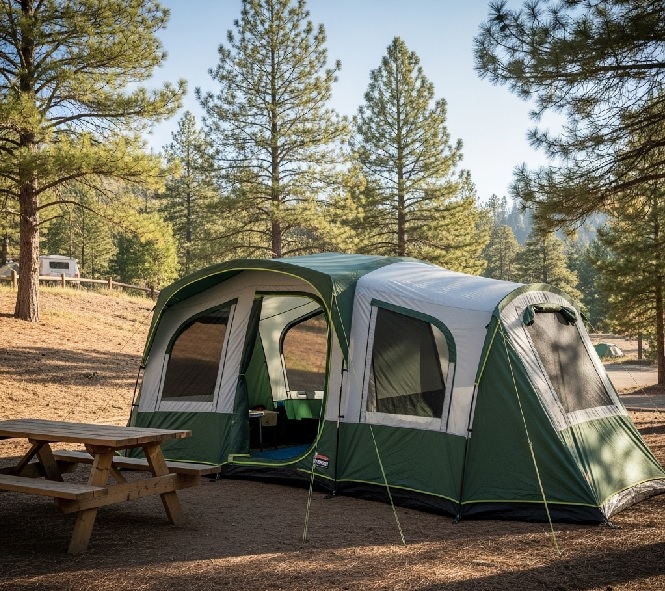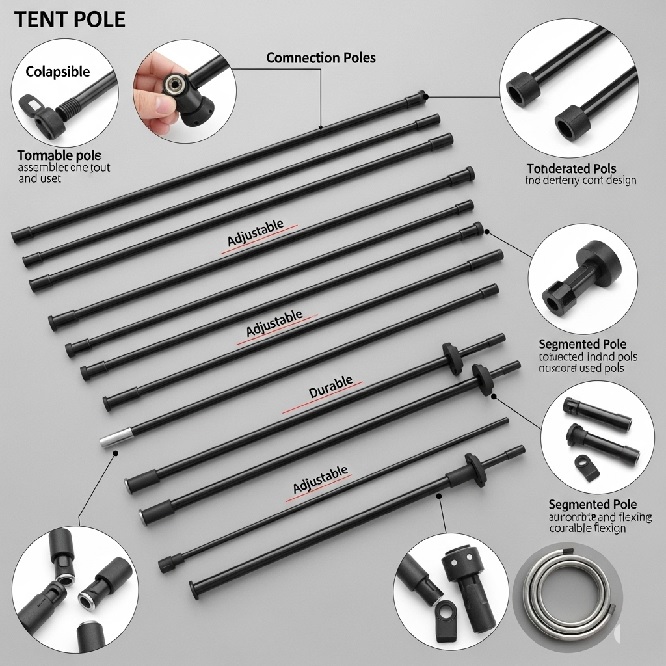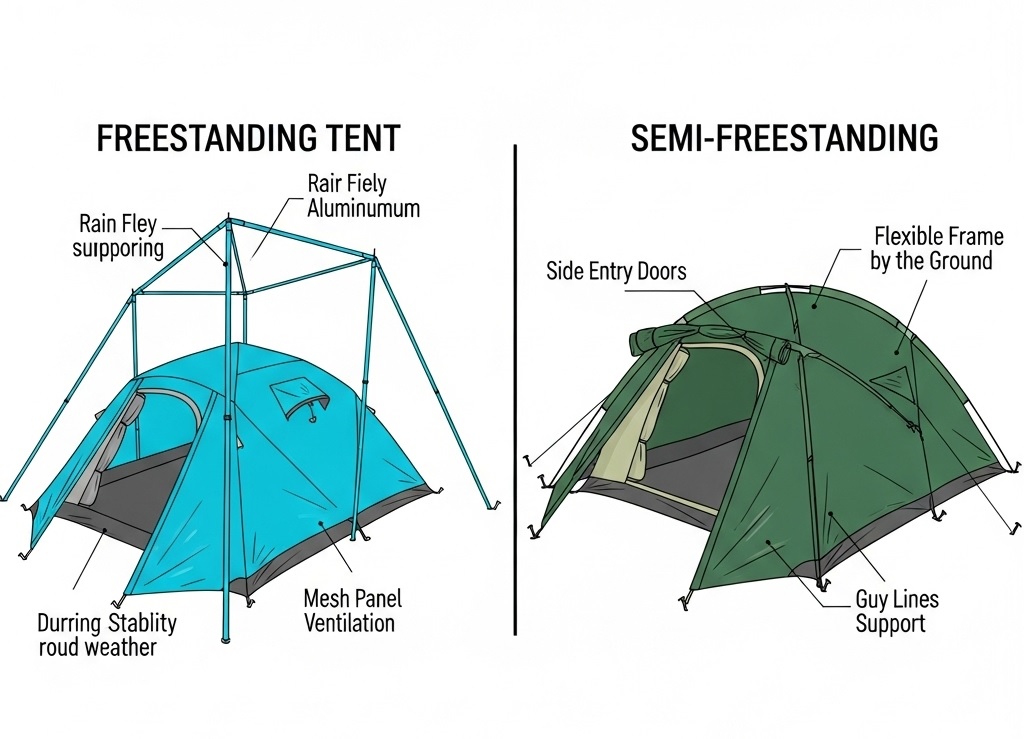This blog post may contain affiliate links. As an Amazon Associate I earn from qualifying purchases.
Choosing the right tent can make or break your outdoor adventure. Picture yourself under the stars, surrounded by the peaceful sounds of nature.
But there’s a decision to be made: freestanding or semi-freestanding tent? This choice might seem small, but it can significantly impact your comfort and convenience during your trip. Imagine the ease of setting up your tent in any location versus the potential struggle with uneven ground.
You want to enjoy your time outside, not wrestle with your shelter. We will break down the differences between these two types of tents, helping you make an informed decision that enhances your camping experience. Stick with us, and discover which tent is your perfect match for your next outdoor escapade.
Freestanding Tents
The choice between a Freestanding Tent and a Semi Freestanding Tent can greatly impact your outdoor adventures. Each has its unique benefits, catering to different needs in camping gear. The Freestanding Tent stands out due to its ease and versatility. It offers a simple solution for campers who value quick tent setup and reliable stability. This type of outdoor shelter is popular among backpackers and campers for its all-around performance. Let’s explore the key features, advantages, and ideal uses of Freestanding Tents.
Key Features
Freestanding Tents have distinct characteristics that make them a preferred choice for many adventurers. These tents maintain structure without needing stakes, making them easy to relocate and adjust. Here are some key features:
- Tent Setup: Quick and straightforward, requiring minimal effort.
- Weather Resistance: Designed to withstand various weather conditions, offering protection from rain and wind.
- Tent Stability: Provides a stable structure even on uneven ground.
- Space Efficiency: Offers ample room inside, maximizing comfort.
In terms of materials, Freestanding Tents often use lightweight yet durable fabrics. This enhances weight distribution, making them suitable for backpacking tents. The easy mobility is a significant plus, especially in unpredictable weather.
Advantages
The advantages of Freestanding Tents go beyond their structural benefits. They offer flexibility and convenience that many campers appreciate:
- Ease of Use: Freestanding Tents allow easy repositioning without the hassle of re-staking.
- Versatility: Suitable for various terrains, from rocky surfaces to sandy beaches.
- Durability: Built to withstand harsh conditions, offering long-term use.
- Portability: Light materials ensure easy carrying as part of camping gear.
Their robust design makes them ideal for those who encounter diverse environments. The ability to handle different terrains and weather conditions makes Freestanding Tents a reliable choice for any outdoor shelter.
Ideal Uses
Freestanding Tents are versatile, making them ideal for many outdoor activities. Here are some scenarios where they shine:
- Backpacking: Their lightweight nature makes them perfect for backpacking tents, where ease of transport is crucial.
- Camping: Offers a comfortable and spacious shelter for camping trips in various locations.
- Festivals: Quick setup and takedown make them perfect for festival-goers needing a reliable shelter.
- Adventure Trips: Their weather resistance and tent stability are assets for adventure seekers facing unpredictable conditions.
Freestanding Tents excel in situations where space efficiency and mobility are necessary. Whether navigating through a forest or setting camp on a rocky hillside, these tents provide a dependable and adaptable shelter solution.
Also Read: Tent Footprint Vs Tarp: Ultimate Gear Showdown
Semi Freestanding Tents
Choosing the right outdoor shelter can greatly impact your camping experience. The debate between freestanding and semi freestanding tents often centers around setup ease and portability. Semi freestanding tents offer a unique blend of stability and lightweight design. These tents provide a middle ground between the completely freestanding tent and those requiring full staking. Understanding the key features, advantages, and ideal uses of semi freestanding tents can help you make an informed decision for your next outdoor adventure.
Key Features
Semi freestanding tents are known for their unique tent design, offering a balance between stability and lightweight portability. Below are some noteworthy features:
- Ease Of Setup: These tents typically require fewer stakes than non-freestanding tents, making setup quicker.
- Weight Distribution: Designed to distribute weight efficiently, they often use less material, making them lighter.
- Versatile Structure: Provides enough stability to withstand moderate winds and weather conditions.
- Compact Packing: Usually packs smaller than freestanding tents, ideal for backpacking.
Here is a simple table showing the comparison with freestanding tents:
| Feature | Semi Freestanding Tent | Freestanding Tent |
|---|---|---|
| Setup | Quick | Very Quick |
| Stability | Moderate | High |
| Weight | Light | Heavy |
Advantages
Semi freestanding tents offer several advantages that make them a popular choice among campers:
- Portability: These tents are lighter, making them easier to carry in your camping gear.
- Enhanced Tent Stability: While not entirely freestanding, they provide enough stability for most camping conditions.
- Cost-Effective: Generally more affordable than fully freestanding tents.
- Ease Of Setup: Requires fewer stakes, allowing for quick setup even in rocky or hard soil areas.
These features make semi freestanding tents a preferred choice for those who value a balance between tent stability and ease of setup.
Ideal Uses
Semi freestanding tents are versatile and serve well in various camping scenarios:
- Backpacking Trips: Their lightweight design and portability make them perfect for long treks.
- Weekend Getaways: Quick setup and compact packing are ideal for short, spontaneous trips.
- Hiking Adventures: Suitable for moderate terrain where complete staking might be challenging.
- Family Camping: Offers enough room while being easy to transport and set up.
These tents adapt well to different camping conditions, providing a reliable shelter without the bulk or complexity of a freestanding tent.

Comparison Of Both Types
Tents are a crucial part of camping gear, offering shelter in the great outdoors. Choosing between a freestanding tent and a semi-freestanding tent can make a big difference in your camping experience. Both types have their unique features and benefits. Understanding the comparison between these two can help you make the best choice for your outdoor adventures.
Weight And Portability
When considering tent weight and portability, both freestanding and semi-freestanding tents have their merits. A freestanding tent is typically heavier, due to its robust design and poles that provide structure without the need for stakes. This type of tent can be easily moved around to find the perfect spot.
On the other hand, a semi-freestanding tent is generally lighter. This makes it an excellent choice for backpacking tents, where every ounce matters. The reduced weight enhances tent portability, allowing you to carry it with ease during long hikes.
- Freestanding Tent: Heavier but offers easy relocation.
- Semi-Freestanding Tent: Lighter and ideal for backpacking.
| Feature | Freestanding Tent | Semi-Freestanding Tent |
|---|---|---|
| Weight | Heavy | Light |
| Portability | Moderate | High |
Setup Process
Freestanding tents offer a straightforward setup process. Their design allows campers to set them up without needing stakes for support. This ease of tent setup can be beneficial in rocky or hard terrain where staking is difficult.
Semi-freestanding tents require a bit more effort during setup. They rely on stakes to maintain their structure, which can be challenging in certain terrains. Despite this, many campers appreciate the stable setup process, especially in soft or sandy ground where stakes hold firmly.
- Freestanding Tent: Quick and easy setup.
- Semi-Freestanding Tent: Requires staking for stability.
Stability In Weather
Weather stability is crucial for a comfortable camping experience. Freestanding tents excel in this area due to their robust tent design. They handle wind and rain well, providing reliable outdoor shelter.
Semi-freestanding tents also offer good weather stability. Their anchored setup process ensures that they remain stable in harsh conditions. However, they might require additional staking in windy situations to enhance their stability.
- Freestanding Tent: Offers superior stability against wind and rain.
- Semi-Freestanding Tent: Provides stable shelter but may need extra staking.
Choosing between these tent types depends on your camping needs. Consider the environment and weight you are willing to carry. Each type offers unique advantages that can enrich your outdoor experiences.
Read More: Tent Vs Teepee: Which Shelter Suits Your Adventure?
Choosing The Right Tent
Choosing the right tent can make or break your outdoor adventure. Whether you’re a seasoned backpacker or a weekend camper, understanding the difference between freestanding and semi-freestanding tents is crucial. Each type has its own set of benefits and drawbacks, making your choice largely dependent on your specific needs. This guide will help you navigate through the options, ensuring you pick the tent that will best suit your camping style and environment.
Consider Your Needs
Understanding your personal camping needs is the first step in choosing the right tent. Freestanding tents are known for their versatility and ease of setup. They can stand on their own without stakes, making them ideal for rocky or hard surfaces. Semi-freestanding tents, while still versatile, require some staking for full setup. Think about the following:
- Camping Frequency: If you camp often, durability is key.
- Group Size: More people mean larger tents. Consider the interior space.
- Weather Conditions: For areas with high winds, a sturdy structure is essential.
- Weight: Lightweight options are better for backpacking.
Use this table to help decide:
| Feature | Freestanding | Semi-Freestanding |
|---|---|---|
| Setup Ease | Very Easy | Easy with Stakes |
| Versatility | High | Moderate |
| Weight | Heavier | Lighter |
Budget Factors
Your budget plays a significant role in choosing a tent. Freestanding tents often come with a higher price tag due to their more complex pole structures. This can be a consideration if you are looking for long-term durability and ease of use. Semi-freestanding tents are generally more affordable, making them a great choice for those on a tighter budget.
Here are some budget considerations:
- Initial Cost: Freestanding tents can be more expensive.
- Longevity: Spending more initially can mean less frequent replacements.
- Accessories: Consider the cost of additional stakes and repair kits.
Balancing cost with functionality ensures you get the best value. Investing wisely in a tent that fits your needs can enhance your camping experience.
Terrain Considerations
The terrain you’ll encounter significantly impacts your tent choice. Freestanding tents excel in uneven or rocky terrains due to their ability to stand without stakes. Semi-freestanding tents might require more effort to secure, especially on soft ground.
Factors to consider include:
- Ground Type: Rocky or hard surfaces benefit from freestanding designs.
- Space Availability: Limited space may restrict staking options.
- Weather Impact: Consider wind exposure and potential rainwater pooling.
For those camping on varied terrain, a freestanding tent offers flexibility and ease. Assessing your typical camping conditions will guide you to the right choice, ensuring comfort and safety during your outdoor adventures.
Popular Models
Camping enthusiasts often debate the merits of Freestanding Tents versus Semi Freestanding Tents. Choosing the right tent can make or break an outdoor adventure. Popular models in both categories offer diverse features tailored to different camping preferences. Whether you’re seeking ease of setup or lightweight design, understanding popular models can enhance your camping experience. Dive into the world of Freestanding and Semi Freestanding tents to discover which best suits your needs.
Freestanding Options
Freestanding Tents are beloved for their easy setup and versatile design. These tents stand without stakes, offering flexibility in various terrains. Popular models in this category emphasize portability and strength. Here are some standout choices:
- MSR Hubba Hubba NX – Known for its compact size and lightweight nature. It’s a favorite among backpacking tents, allowing easy transport.
- Big Agnes Copper Spur HV UL2 – Offers excellent space and ventilation. Its tent design is perfect for those who value comfort.
- REI Co-op Half Dome 2 Plus – Provides ample room and stability. Ideal for campers who prioritize durability.
Freestanding tents often feature lightweight materials, making them suitable for backpacking. Their tent stability ensures they stand firm even in windy conditions. Consider your camping preferences when selecting a model.
| Model | Weight | Capacity |
|---|---|---|
| MSR Hubba Hubba NX | 3 lbs 8 oz | 2 people |
| Big Agnes Copper Spur HV UL2 | 3 lbs 2 oz | 2 people |
| REI Co-op Half Dome 2 Plus | 4 lbs 9 oz | 2 people |
Semi Freestanding Options
Semi Freestanding Tents offer a mix of lightweight design and tent stability. They require minimal staking, providing increased security in uneven landscapes. Popular models in this group focus on efficiency and compactness. Explore these options:
- Nemo Hornet Elite – Renowned for its ultralight weight. Perfect for solo backpackers seeking ease of transport.
- Tarptent Double Rainbow – Offers spacious accommodation with minimal weight. Great for couples on the move.
- Six Moon Designs Lunar Solo – Features a single-pole setup. Suited for campers who prefer simplicity in tent setup.
Semi Freestanding tents excel in tent design, often incorporating innovative features for enhanced performance. These outdoor shelters cater to campers prioritizing efficiency and camping gear optimization. Choose based on your specific camping needs and the environments you plan to explore.
| Model | Weight | Capacity |
|---|---|---|
| Nemo Hornet Elite | 1 lb 11 oz | 1 person |
| Tarptent Double Rainbow | 2 lbs 10 oz | 2 people |
| Six Moon Designs Lunar Solo | 1 lb 10 oz | 1 person |
User Experiences
Choosing the right camping tent can make or break your outdoor adventure. Among the popular options, Freestanding Tents and Semi-Freestanding Tents offer unique benefits and challenges. Understanding user experiences can help you make an informed decision. Campers often share their thoughts on setup ease, tent stability, and other tent features. Let’s dive into the experiences of those who’ve used these tents.
Testimonials
Many campers have shared their experiences with Freestanding and Semi-Freestanding Tents. These insights help others understand the real-world applications of these camping tents. Here’s what some of them had to say:
- Freestanding Tents: Users often highlight the ease of setup. These tents usually stand without needing stakes, making them ideal for rocky or hard surfaces. One camper mentioned, “I love how quickly I can set up my Freestanding Tent, especially when the weather turns bad.”
- Semi-Freestanding Tents: These tents often require fewer stakes than other types. Campers appreciate their lightweight design, which is perfect for backpacking. A frequent hiker shared, “The Semi-Freestanding Tent was a lifesaver on my long trek. It was light in my pack and easy to pitch with just a few stakes.”
Users also discuss the tent weight and how it affects their camping experience. Freestanding Tents tend to be bulkier, while Semi-Freestanding Tents offer a balance between weight and stability. Comparing these aspects helps campers choose the right outdoor gear for their needs.
Common Issues
While many campers praise these tents, some common issues come up during their use. Understanding these can prepare you for potential challenges.
- Freestanding Tents: Despite their easy setup, some users find these tents less stable in strong winds. A camper noted, “My Freestanding Tent needed extra stakes during a windy night to keep it secure.”
- Semi-Freestanding Tents: A common issue is the need for at least a few stakes to achieve full stability. One user mentioned, “I forgot my stakes and struggled a bit with my Semi-Freestanding Tent in loose soil.”
Another concern is tent weight. Freestanding Tents can be heavier, impacting long hikes or backpacking trips. Users often weigh the pros and cons of tent stability versus mobility. This tent comparison helps campers decide which camping equipment suits their style best.

Frequently Asked Questions
What Is The Difference Between Freestanding And Semi Freestanding Tents?
Freestanding tents have poles that hold their shape independently without stakes. Semi-freestanding tents need stakes for full stability. Freestanding options offer easier setup and relocation. Semi-freestanding tents are lighter, making them ideal for backpacking. Choose based on terrain and preference for convenience or weight savings.
Are Freestanding Tents Better?
Freestanding tents offer easy setup and stability on various terrains. They are ideal for unpredictable weather. These tents don’t require stakes, making them versatile. Some campers prefer them for their convenience and adaptability. However, non-freestanding tents can be lighter and more compact.
Choose based on your camping needs and preferences.
What Is The Difference Between Freestanding And Tension Tents?
Freestanding tents use poles for structure, offering easy setup and mobility. Tension tents rely on external support, like ropes and stakes, for stability, requiring more setup time. Freestanding tents are ideal for versatile terrains, while tension tents are suited for open spaces where staking is possible.
Do You Need To Stake A Freestanding Tent?
Yes, staking a freestanding tent is recommended for stability. Stakes prevent the tent from shifting in wind or uneven terrain. While freestanding tents can stand alone, stakes enhance security and comfort. Always check the terrain and weather conditions to decide the best staking method for your tent setup.
Conclusion
Choosing the right tent affects your camping experience. Freestanding tents offer easy setup and stability. Great for varied terrains. Semi-freestanding tents need some extra effort. But they are lighter and compact. Ideal for backpackers. Consider your camping style and destination.
Think about weather conditions and terrain. Make sure your tent suits your needs. Comfort and convenience matter. Both tent types have pros and cons. Weigh them carefully. Your choice should enhance your adventure. Enjoy the great outdoors with the right gear.
Happy camping!


